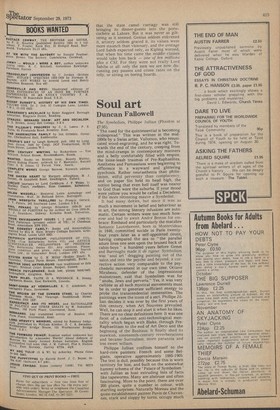An antique land
Jan Morris
Palaces Of The Raj Mark Bence-Jones (Allen and Unwin E5) If the Empire still survived, and India offered an arena for our national energies, who would now be our pro-consuls in the Raj? Lord Caccia would be Viceroy, of course. Lord Soper might be a progressive Governor of Bombay. One can see Mr Vic Feather preparing to assume the mantle of new dignities at Calcutta, and even Mr Wilson, born to different historical circumstances, might preside to the manner born over the balls, soirees and swimming-pools of Allahabad.
Able men, in short, outstanding even, but still not quite the most striking, gifted or imaginative characters our nation produces. So it generally was, especially in the latter years of the Raj. Just as one cannot in any circumstances imagine the Duke of Bedford receiving the Queen's birthday guests at Poona, so Lord Salisbury never even got as far as Ireland, let alone India. I can just fancy Mr Muggeridge as a forceful if reactionary Governor of the Punjab, but for every Lawrence, Lytton or Curzon, in the heyday of the Raj, there were a dozen worthy secondraters, temporarily resplendent.
A distressing note of sycophancy, I have observed, is now entering popular studies of these matters. It is a note of sentimental awe. It is not expressed by former practitioners of Empire, who are commendably restrained in their nostalgia, nor of course by the ageing intellectuals who put paid to it, but by the post-imperial generation, indulging in the inevitable backlash of history. It is affection without irony, frankness without realism, pastiche without satire. It makes much of the forms and splendours of Empire, while largely ignoring the substance.
A trace of such an attitude weakens Mr Bence-Jones's vivacious study of gubernatorial manners in British India. He has used as the index of his narrative the grand houses in which his heroes and heroines lived out their days of sweat and splendour, but his is not really an architectural work. It is an anecdotal pot-pourri of reminiscence about viceroys governors-general, governors, lieutenant' governors and all their wives, sisters, governesses and aides-de-camp, and it is too courtier-like by half. As a little boy Mr Bence-Jones used to be friends with the grand-children of the Governor of the Punjab, and he has retained a taste for grandeur. Perhaps he sometimes has his tongue in his cheek, as he offers us the statistics, pageafl. tries and pretensions of that old sovereigntY, but he more often gives the impression that at heart he is walking backwards down the Durbar Hall, bowing at intervals towards Their Excellencies.
There is an important book to be written about the architecture of British India, preferably by Mrs Mildred Archer, who has already done the job for the pictorial art of the Raj. In Palaces of the Raj Mr Bence-Jones has missed the chance, but even so much the best parts of his book are those that are specifically architectural. His pictures are poor, his ground plans are drawn from memory, but his descriptions of the houses themselves can be very effective, and are full of curious insights. How agreeable to know that Maples furnished and decorated Viceregal Lodge at Simla! How fascinating to learn that the domed dining-room of Government House, Lahore, was originally the tomb of Akhbar's cousin Mohammed Kasim Khan! I would love to read more about the professional relationship between Lutyens and Baker, in the building of New Delhi, and the reactions of the Governors' ladies to their official mansions, their ideas on gubernatorial decor and imperial furnishing, make enthralling reading always. But Government Houses are artifacts not of social, but of political history, and while Mr Bence-Jones is busy quoting gay nothings from Miss Yvonne FitzRoy's diaries, or telling another tale of Lord Bill Beresford, that 'beau-ideal' of Viceregal courtiers, he forgets to discuss why the palaces were there, or whether they should have been. His British characters seem to be beyond right or wrong — the most terrible soldier of the Raj IS blandly characterised as "the gallant Hod' son": his Indians are irritating if they are intellectuals, good if they are peasants and highly recommended if they have left portraits of Viceroys in situ on ballroom walls. And he does not answer the most piquant of the questions posed by those astonishing mansions. Were they really necessary? Was not their preposterous pomp no more than a sop to the-very Indian values the imperialistS professed to despise? Would not the Empire have prospered just as well in powerful modesty? And when, so near to the end, the Raj built itself that culmination of the imperial ethos, New Delhi, what did the imperialists really have in mind? Mr Hence' Jones tells us that Edwin Montagu seriouslY wondered if Lutyens's great house would be big enough, despite its 600-foot facade, its; twelve courtyards and its community 01 nearly 6,000 souls: and Lutyens himself, mindful of a superstition that the Raj would last as long as the bells of Delhi were silent, carefully built stone bells into the capitals of .his unorthodox columns. I believe, reading between his lines, that Mr Bence-Jones too wishes the Empire had never ended, that scarlet and gold ADCs were still flirting with Governors' nieces in the garden, that the state camel carriage was still bringing its dinner-guests into the portecochere at Lahore. But it was never as gilttering as it seemed. Genius seldom enlivened it, artistry seldom graced it, its values were more staunch than visionary, and the average Lord Sahib expected only, as Kipling warned, that when his time came the middle classes would take him back — one of ten millions plu,s. a CSI. For they were not really Lord Sahibs at all: only the men we see now discussing pay pauses and crime rates on the telly, or sitting on boring boards.











































 Previous page
Previous page